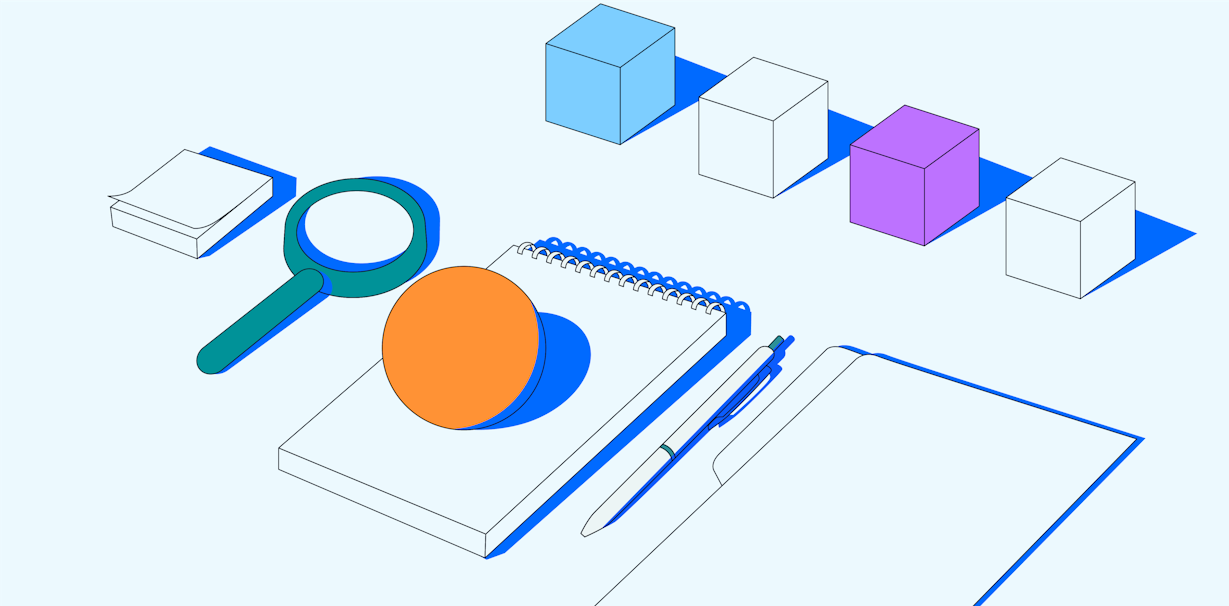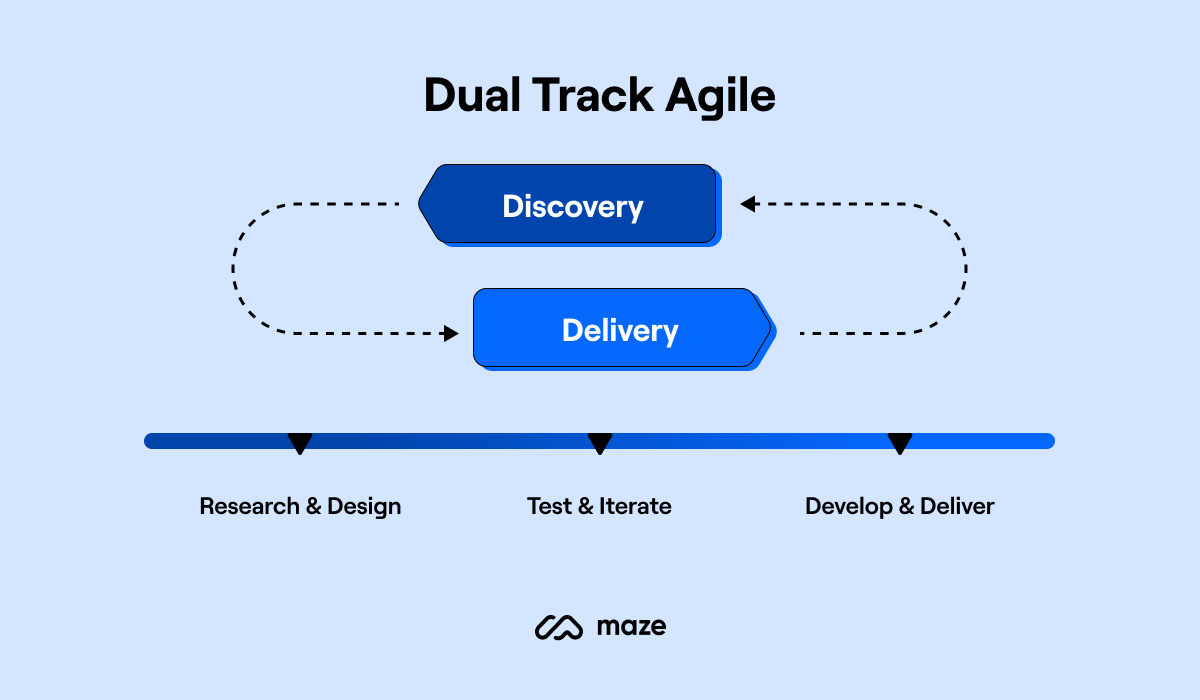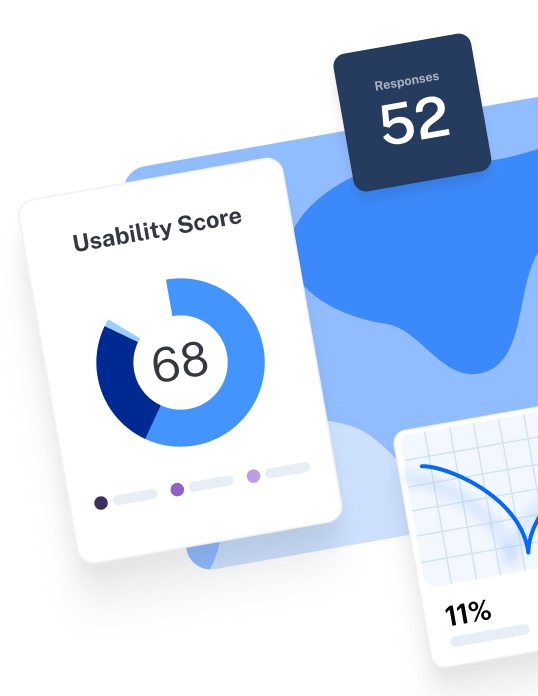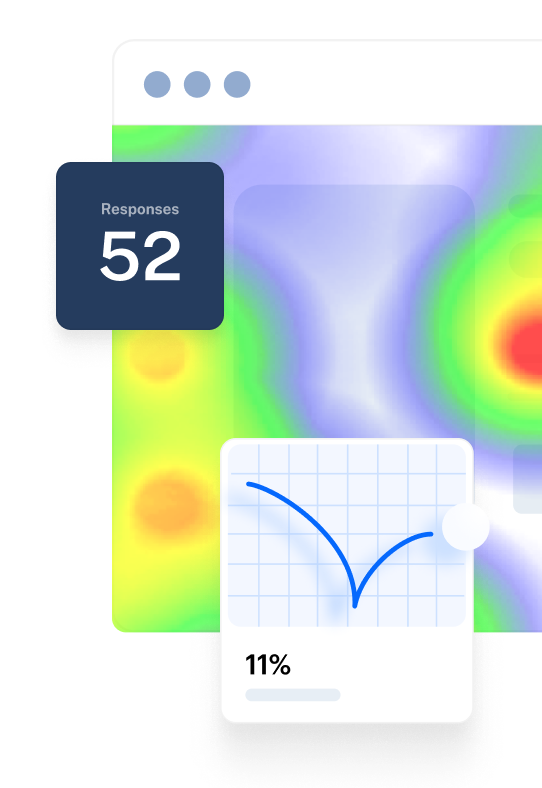
What is UX Research: The Ultimate Guide for User Researchers
User experience research is a crucial component of the human-centered design process and an essential part of creating solutions that meet user expectations and deliver value to customers. This comprehensive guide to UX research dives into the fundamentals of research and its various methods and includes tips and best practices from leading industry experts.
Chapter 1
UX research: Your ultimate guide to nailing user experience and exceeding expectation
TL;DR
UX research helps teams build the right product for their users by understanding how real users experience it, not just what they say. Unlike broad user research, UX research focuses on user interactions and is a continuous process across the product lifecycle. It reduces bias, validates decisions, improves buy-in, and ensures the product delivers value that users can recognize.
User experience research, or UX research, is the process of gathering insights about users' behaviors, needs, and pain points through observation techniques and feedback methodologies. It’s a form of user research that looks at how users interact with your product, helping bridge the gaps between what you think users need, what users say they need—and what they actually need.
The goal of UX research is to understand your users and gain context and perspectives to help make informed decisions and build user-centered products. It’s an essential part of designing, developing, and launching a product that will be an instant hit—but it should also be used throughout the product’s lifecycle post-launch to keep updated, and ensure new features are relevant to your audience.
As Sinéad Davis Cochrane, UX Manager at Workday, explains: “UX research represents insights gathered directly from users and customers, that helps you make product decisions at every stage of the development process.”
Is UX research the same as user research?
The terms ‘user research’ and ‘UX research’ are often used interchangeably, but they do differ. User research is the parent of UX research; it’s a broader research effort that aims to understand the demographics, behaviors, and sentiments of your users and personas.
UX research, on the other hand, is a type of user research that’s specific to your product or platform. Where user research focuses on the user as a whole, UX research considers how they interact with, respond to, and feel about your product or concept itself.
In both cases, the overarching goal is to get to know your users, understand what they need from your product, gain context to help make informed decisions, and build human-centered experiences.
Why is conducting UX research important?
In an ideal world, users would find your product easy to navigate, your net promoter score (NPS) would be off the charts, and you’d see adoption and activation rates skyrocket. In reality, however, this can be a challenging dream to achieve—but it is possible. The only way to build a product that users really resonate with is by involving them throughout the development process and building with them.
Tip ✨
UX research is more than just a single ‘step’ in the development process: it should happen continuously, throughout the product lifecycle—so whether you’re building new products or iterating on existing ones, every decision is informed by user insights.
Here’s what you can achieve with continuous UX research:
Make informed decisions based on data
Our 2023 Continuous Research Report shows that 74% of people who do research (PWDR) believe research is crucial to guiding product decisions. Plus, 60% of respondents find that user recommendations inspire new product ideas.
Getting stakeholder buy-in to product decisions can be challenging, but when you suggest changes based on UX research, you have data to back up your suggestions. Your users inform your product, becoming the decision-makers as well as the customer.
UX research helps reduce and mitigate the risk of building the wrong thing—or building the right thing in the wrong way.

Sinéad Davis Cochrane
UX Manager at Workday
Reduce bias in the UX design process
There are hundreds of cognitive biases identified by psychologists, many of which unknowingly influence our decisions and the products we build. But a key principle of great UX design is to put aside existing beliefs, and learn from your users.
“You have to be humble, optimistic, and open-minded,” says Bertrand Berlureau, Senior Product Designer at iMSA. Using effective UX research, you can root out bias or assumptions, and follow real human behavior to inform product decisions.
According to Sinéad, you should consider these questions early in the design process:
- “What are your assumptions?”
- “What are some of the assumptions you’ve been making about your end-users and product without any evidence?”
- “What are the anecdotes or coincidental pieces of information that you hold, and how can you challenge them?”
Tip ✨
Biases can subconsciously affect research and UX design, and it can be tricky to identify them. The first step to overcoming cognitive biases is by being aware of them. Head to chapter three of our cognitive biases guide to discover how.
Test and validate concepts
The power of UX research is that it can prove you right or wrong—but either way, you’ll end up knowing more and creating a product that provides a better user experience. For Bertrand, an idea without a test is just an idea. So, before the design process, his team starts with these user research methods:
- Face-to-face and remote user interviews
- Focus groups
- Co-creativity sessions through design sprints, quick prototyping, and hypothesis concepts
- User testing
UX research is the only way to unequivocally confirm your product is solving the right problem, in the right way. By speaking directly to real users, you can pinpoint what ideas to focus on, then validate your proposed solution, before investing too much time or money into the wrong concept.
Work on solutions that bring real value to customers
Another main benefit of UX research is that it allows product teams to mitigate risk and come up with products users want to use. “One of the main risks we need to control is whether users actually want to use a solution we've implemented,” explains Luke Vella, Group Product Manager at Maze. “UX research helps us reduce this risk, allowing us to build solutions that our customers see as valuable and make sure that they know how to unlock that value.”
Luke works on pricing and packaging, an area that requires constant user research. On one hand, he and his team want to understand which problems their users are facing and come up with plans to satisfy those different needs. On the other hand, they need to make sure they can monetize in a sustainable way to further invest in the product. You can only get this perfect balance by speaking to users to inform each step of the decision.
Market your product internally and externally
UX research also plays a crucial role in helping product marketers understand the customer and effectively communicate a product's value to the market—after all, a product can only help those who know about it.
For example, Naomi Francis, Senior Product Marketing Manager at Maze, uses different research methods to inform marketing strategy. Naomi conducts user interviews to build personas, using user research to collect insights on messaging drafts, product naming, and running surveys to gather user feedback on beta products and onboarding.
Understanding how and why customers need and use our product pushes marketing launches to the next level—you can get a steer on everything from messaging to language and approach.

Naomi Francis
Senior Product Marketing Manager at Maze
Types of UX research
All UX research methods fit into broader UX research techniques that drive different goals, and provide different types of insight. You can skip to chapter seven for a rundown of the top 9 UX research methods, or keep reading for a deep dive on the main types of UX research:
- Moderated and unmoderated
- Remote and in-person
- Generative and evaluative
- Qualitative and quantitative
- Behavioral and attitudinal
Where moderated/unmoderated and remote/in-person refer to the way research is conducted, the other types of UX research reflect the type of data they gather.
The most powerful insights come from a mixture of testing types—e.g. attitudinal and behavioral, generative and evaluative, and quantitative and qualitative. You don’t need to run all types of research at all times, but you’ll benefit from gathering multiple types of data throughout different stages of product development.
Moderated research
Moderated research is any research conducted with a facilitator or researcher present. A moderator may observe research sessions and take notes, ask questions, or provide instruction to participants where needed.
Like all research, it’s crucial a moderator doesn’t overly guide participants or influence results. Due to certain types of cognitive biases, people may behave differently while being observed, so researchers often opt for unmoderated methods to avoid results being impacted.
UX research methods for moderated research
- User interviews to speak directly with your target user face-to-face
- Focus groups to gather feedback on a variety of topics
- Moderated usability testing to hear the thought process behind the actions
Unmoderated research
As the name suggests, unmoderated research refers to the lack of a moderator. Often used in tandem with remote research, users complete tasks independently, guided by pre-written instructions.
Unmoderated research is helpful to ensure users are acting entirely of their own volition, and it has a lower cost and quicker turnaround than moderated research—however it does require efficient planning and preparation, to ensure users can navigate the tasks unaided.
UX research methods for unmoderated research
- Unmoderated usability testing to see how easily users navigate your product
- Live website testing to witness users interacting with your product in real time
- UX surveys to have users answer specific questions and rate design elements
Remote research
An incredibly flexible approach, remote research is often favored due to its time-to-results and cost savings. Remote research can be moderated or unmoderated, and is conducted using UX research tools which record user behavior, feedback, and screen recordings.
Another key benefit is its reach and accessibility—by moving research to a virtual platform, you can access users from anywhere in the world, and ensure research is inclusive of those with different abilities or requirements, who may otherwise be unable to take part in traditional in-person research.
UX research methods for remote research
- Usability testing to evaluate how accessible your product is
- Card sorting to understand how users categorize and group topics
- Concept testing to assess what ideas users are drawn to
- Wireframe or prototype testing to invite users to test a rough version of the design
In-person research
Research conducted in-person is typically more expensive, as it may require travel, accommodation, or equipment. Many traditionally in-person research methods can easily be performed remotely, so in-person research is often reserved for if there’s additional needs for accessibility, or if your product requires physical testing, safety considerations or supervision while being tested.
UX research methods for in-person research
- Guerrilla research to speak to random users and gather feedback
- User interviews to connect with users and read body language
- Field studies to gauge how your product fits into a real world environment
Generative research
Generative research provides a deep understanding of your target audience’s motivations, challenges, and behaviors. Broadly speaking, it pinpoints a problem statement, identifies the problem to be solved, and collects enough data to move forward.
It should happen before you even begin designing, as it helps you identify what to build, the types of problems your user is facing, and how you can solve them with your product or service.
UX research methods for generative research
- Field studies to get familiar with users in their authentic environment
- User interviews to ask open-ended questions about pain points
- Diary research to keep a log of users’ behaviors, activities, and beliefs over time
- Open card sorting to have users define and name their own categories
Evaluative research
Evaluative research focuses on evaluating a product or concept in order to collect data that will improve the solution. Evaluative research usually happens early on and is used in a continuous, iterative way throughout the design process and following launch. You can use this type of UX research to assess an idea, check navigation, or see if your prototype meets your user’s needs.
UX research methods for evaluative research
- Usability testing to see if your platform is easy and intuitive to use
- A/B testing two versions of a design to see which one works best
- Tree testing to assess if your website’s information architecture (IA) makes sense
- Five-second tests to collect first impressions
Behavioral research
This type of research refers to observation—it’s human nature that sometimes what we say, or what we think we’ll do doesn’t match up to what we actually do in a situation. Behavioral research is about observing how users interact with your product or how they behave in certain situations, without any intervention.
UX research methods for behavioral research
- Observation in labs or real environments to witness behavior in real time
- Tree testing to view which paths users take on a website
- Diary research to see how users interact with your product in real life
Attitudinal research
Attitudinal research is the companion to behavioral research—it’s about what people say, and how they feel. In attitudinal research, you ask users to share their own experiences and opinions; this may be about your product, a concept, or specific design element. With a mix of attitudinal and behavioral research, you can get a broader picture of what your user truly needs.
UX research methods for attitudinal research
- Focus groups to understand users’ perspectives on your product
- User interviews to ask people questions about your product directly
- Surveys to gather insights on user preferences and opinions
Quantitative research
Quantitative and qualitative research methods are two types of research that can be used in unison or separately. Quantitative research comes from data and statistics, and results in numerical data.
It allows you to identify patterns, make predictions, and generalize findings about a target audience or topic. “[At iMSA] We analyze a lot of metrics and specific data like traffic analytics, chatbot feedback, user surveys, user testing, etc. to make decisions,” explains Bertrand. “The convergence of all the data, our user’s needs, governs the choices we make.”
Types of quantitative results you can find through UX research include:
- Time spent on tasks
- Net promoter score (NPS)
- System usability score (SUS)
- Number of clicks taken to complete a task
- Preference percentage on A/B tests
UX research methods for quantitative research
- A/B testing to see which option your users likes best
- Tree testing to get data on which paths users follow on your website
- Usability testing to get a score on system usability
- Heatmaps to spot where users spend most of their session time
Qualitative research
Qualitative research is about understanding the why behind the data. It comes from comments, opinions, and observations—this type of research answers why and how users think or act in a certain way. Qualitative data helps you understand the underlying motivations, thoughts, and attitudes of target users. For this reason, attitudinal research is often qualitative (though not always).
UX research methods for qualitative research
- Interviews to discover your users’ motivations and frustrations
- Open question surveys to learn users’ pain points in their own words
- Focus groups to observe users�’ interacting with your product
- Think aloud usability tests to hear commentary behind each user decision
💡 Product tip:
Maze allows you to record your participants' screen, audio, and video with Clips, so you can collect qualitative and quantitative insights simultaneously.
When should you conduct UX research?
The truth is, you should always be researching. When NASA wants to send a new shuttle into space, they don't build a rocket and launch it right away. They develop a design, test it in simulations and lab environments, and iterate between each stage. Only once they’ve run all the foreseeable scenarios do they put a person on the ship. Why should your product be any different?
With an overwhelming 83% of product professionals surveyed in our 2023 Continuous Research Report believing research should happen at all stages, it’s surprising that just 36% run tests after launch. While time and budget can make continuous research a challenge, testing at different stages gives you access to unique insights about your users and how they interact with your product.

That being said, if you can only afford to research a few times throughout the development process, here are some key moments to focus on:
Before developing the product
This is when you need to conduct the most extensive and detailed part of your research. During this phase, you’ll want to conduct generative research to get to know exactly:
- Who your user is
- The types of problems they’re facing (and what kind of product they want to solve them)
- What their expectations on a product or service like yours are
- What they like or dislike about your competitors
- Where they currently go to solve the mentioned problems
- What needs to happen for them to change companies (if they’re using a different product)
You can use a variety of UX research methods like focus groups and surveys to gather insights during this stage.
Remember: This step applies even if your product is already live, if you’re thinking of introducing a new feature. Validate your idea and investigate potential alternatives before you spend time and money developing and designing new functionality.
When you want to validate your decisions
This is the point where you’ll run through a few cycles of researching, building, and iterating, before launching your product. The Maze Product team does this through continuous product discovery, via a dual-track habit:

Conduct research regularly while developing and building your product to see if you’re headed in the right direction. Let the research findings feed your deliverables.
Gather qualitative insights on user sentiment through surveys or focus groups. Test your wireframe or sketches to get quantitative answers in the form of clicks, heatmaps, or SUS. Use card sorting to generate ideas, tree testing to assess IA, or prototype testing to assess the usability of a beta version. The options are endless, so there’s no reason to miss maximizing your research at this stage and gather insights to power product decisions.
To evaluate product accessibility
Your product will be used by a multitude of diverse, unique users. Your research participants should be representative of your real audience, which means including all usage scenarios and user personas. Usability testing is one form of UX research that can be used here to ensure your product works for all its users, regardless of ability or need.
There are many ways to ensure your design is inclusive and accessible, including:
- Testing alt-texts, screen-reading capabilities, and color combinations
- Avoiding screen flashes or sudden pop-ups that may be triggering for certain conditions
- Being intentional in what language and imagery is used
Once your product is live
Research doesn’t end once you push your platform to production. Conduct Live Website Testing to evaluate how well your product is meeting your users' expectations and needs. This type of research invites you to answer the question: did we nail it?
Testing your live website also allows you to see how your users interact with your design in a real environment, so you can identify and solve mistakes fast. Pay close attention to loading times, error messages, and other quantitative data that may indicate bugs. You can also conduct regular sentiment checks by embedding feedback surveys into your product itself, to assess user satisfaction and NPS in a few clicks.
TL;DR: Why, how, and when to conduct UX research
The more you understand your customers, the better you can create products that meet expectations, tailor your strategy to their specific needs, and increase your chances for success. Plus, UX research allows you to create unbiased products that put your customers at the center of your business.
To conduct UX research, you’ll need to mix the stage of your product lifecycle with the right research type and methods. Meaning, while you need to conduct UX research continuously, you should look for different types of insights depending on the development stage you’re at and what your current objective is.
For example, if you want to test your live product, you should conduct a mix of quantitative and qualitative evaluative research. That means you might want to perform:
- Usability tests
- Feedback surveys
- A/B tests
- Five-second tests
- Prototype testing
Now we’ve covered the what and why of UX research, let’s get into the how. Continue to the next chapter to learn how to create a UX research strategy that blows your competitors away.
Frequently asked questions
What are some examples of UX research?
What are some examples of UX research?
Some examples of UX research include usability testing, user interviews, card sorting, A/B testing, surveys, tree testing, and diary studies. These methods help you understand how users interact with your product, what confuses them, and what works.
Why is UX research important?
Why is UX research important?
UX research is important because it shows you how users behave, what they need, and where your product falls short. It validates decisions with real evidence, reduces the risk of building the wrong product, and helps teams create experiences that are intuitive and genuinely useful.
Is there a difference between user research and UX research?
Is there a difference between user research and UX research?
Yes. User research studies the user as a whole, their habits, goals, frustrations, environment, and decision-making. It tells you who they are and what problems they’re trying to solve. UX research, on the other hand, studies how that same user interacts with your product or prototype. It tells you whether your design works, where they get stuck, and how well your solution fits their needs. UX research is a subset of user research.
Will AI replace UX research?
Will AI replace UX research?
No. AI can speed up parts of the process—like analyzing patterns, summarizing feedback, or automating tests—but it can’t replace real human context. UX research depends on empathy, judgment, and understanding nuance, which AI can’t replicate.
What is the ROI of performing UX research?
What is the ROI of performing UX research?
The most-cited figure comes from a 2016 Forrester study, which found that every $1 invested in UX returns about $100, a 9,900% ROI. You can also save money by catching problems early. The “1:10:100 rule” shows that fixing an issue during research costs about $1, fixing it in development costs $10, and fixing it after release costs $100.




